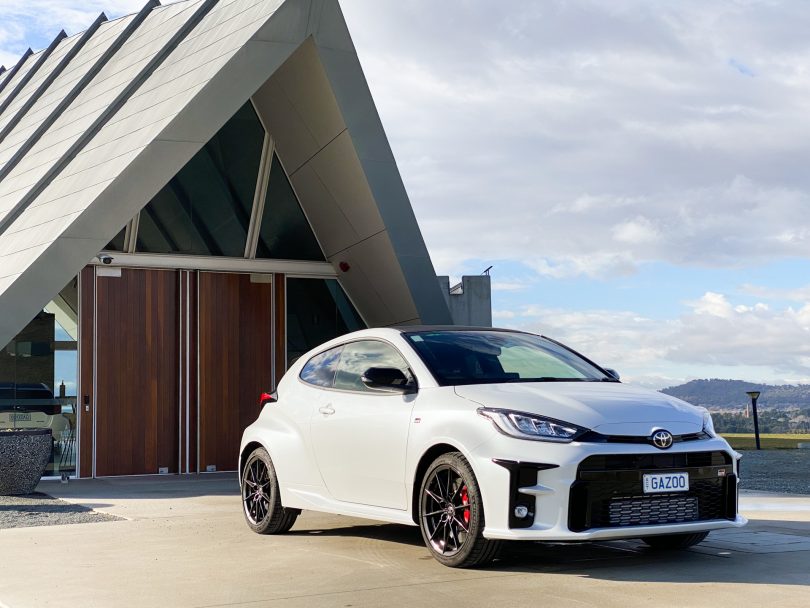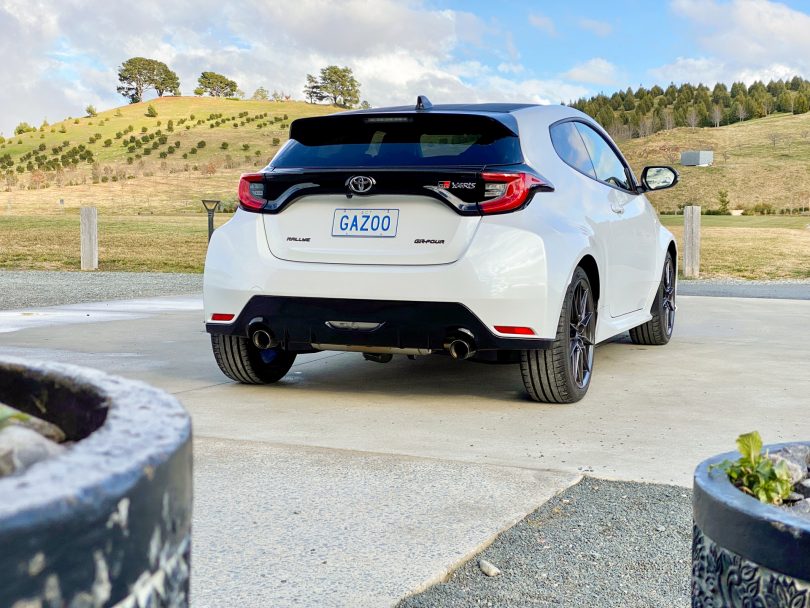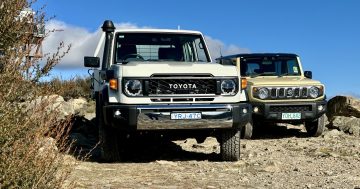
The morning sun brings out the metallic flakes in the white paint of the Toyota Yaris GR. Photo: James Coleman.
Snap the gear lever backwards and the engine responds with a roar. A right foot to the floor and it’s rocketing forward through the hairpin bends with astounding grip and dexterity.
It might not sound like it, but I’ve just described the new Toyota Yaris.
This isn’t an ordinary Yaris, though. In fact, the only things it shares with an ordinary Yaris are the headlights, rear lights and mirrors.
Some background is in order: a few years ago some Toyota engineers set themselves up in a shed at the Nurburgring race track in Germany, calling themselves ‘Gazoo Racing Meisters of the Nurburgring’. They took the smallest Toyota hatchback they could find and experimented with it to create the Yaris GRMN.
It was only ever sold in Europe and in limited numbers. And because it is just as painful to say all the letters individually as it is to put them together, they continued tinkering and presented an updated version to the world in late 2020 called the Yaris GR.
Such was the positive reception, it sold out around the world within months of its launch. Locally, Toyota Australia has suspended any additional orders for six months.

The Toyota Yaris GR shares its rear track width with the Toyota Corolla. Photo: James Coleman.
So when I approached Canberra Toyota about testing one, all they could do was send me in the direction of one of those people who were lucky enough to get a Yaris GR in time.
Shane Wolki is the managing director at Pushys in Fyshwick. Bikes are his business, but cars are his life. He drove for the Aussie Racing Cars Championship for 10 years, and has owned all manner of performance vehicles, most notably a Nissan GT-R. The other car in his garage at the moment is a Mercedes-AMG C63 V8.
“A friend of mine bought a Yaris GR and he took me for a drive around Fyshwick one day,” says Shane. “The moment it was over, I got on the phone to Mirko Milic, the dealer principal at Canberra Toyota, and placed an order then and there.”
So what’s so special about this whitegood?
Everything really.
Shane says Toyota’s boss at the moment is taking the brand in another direction than the one we’ve come to know it for. It seems the designers are being let off the beige, knitted leash and allowed to go to town.

Sporty, but comfortable. The leather and Alcantara seats are even heated. Photo: James Coleman.
Shane’s owns the ‘Rallye’ version, and one of only 200 of them imported to Australia so far.
It’s powered by a 1.6-litre three-cylinder engine, which might sound like the same thing that’s inside your toothbrush, but combined with a turbocharger, it puts out 200 kW. This makes it the most powerful three-cylinder engine ever made.
Adaptive all-wheel drive and a six-speed manual gearbox complete the drivetrain. All the boxes are ticked for the enthusiasts.
However, it doesn’t end there.
The roof is made of carbon fibre and the door and bonnet panels of aluminium to shave off kilograms. The roofline itself has been lowered and the boss wanted it even lower. The front track might be Yaris, but the rear has been widened into Toyota Corolla territory. The muscular haunches are unmissable from any angle.
Other companies might stick a wing on the back, add some black wheels and a turbocharger and call it a day. That would be rich for Toyota, and yet here this is.

The Toyota Yaris GR Rallye version scores 18-inch BBS forged aluminium wheels with Michelin Pilot Sport 4S performance tyres and red brake callipers. Photo: James Coleman.
“You wouldn’t buy this if you didn’t like cars,” says Shane. “It’s a dedicated performance car.”
But why?
Well, Toyota wants to enter the rally stage, and rules for the World Rally Championship (WRC) dictate that in order for a car to compete, at least 25,000 road-going versions must be built.
In other words, Toyota built the Yaris GR first and foremost for rallying and then put the carpets back in to make it suitable for the road.
However, all this effort comes at a cost. The starting price for the Yaris GR Rallye in Australia is $56,200 and $49,500 for the standard GR. That’s a lot for something that doesn’t even have four doors, or much in the way of rear seats.
But look at it like Shane does: “For a daily driver, it’s more fun than the Nissan GT-R. And unlike a GT-R, new tyres don’t cost $3000.”

The Margaret Whitlam Pavilion at the National Arboretum can be reserved for special occasions… and this is one. Photo: James Coleman.
2021 Toyota Yaris GR Rallye
- $56,200 driveaway (first 200 examples)
- 1.6-litre 3-cylinder petrol, 200 kW/370 Nm
- 6-speed manual, AWD
- 0-100 km/h in 5.2 seconds (claimed)
- 7.6 l/100 km fuel usage (combined)
- Safety not yet tested.





















